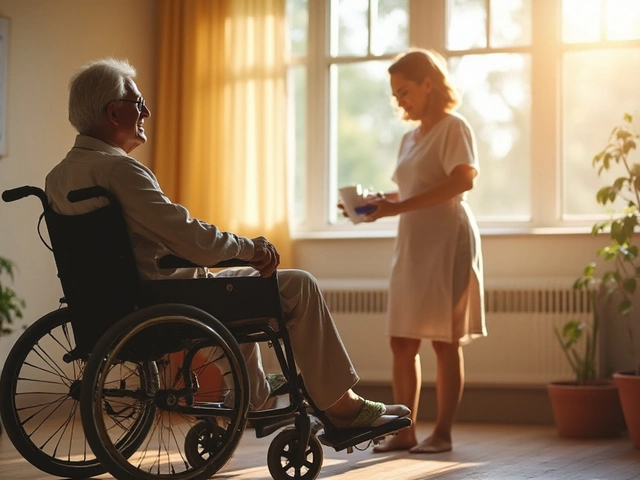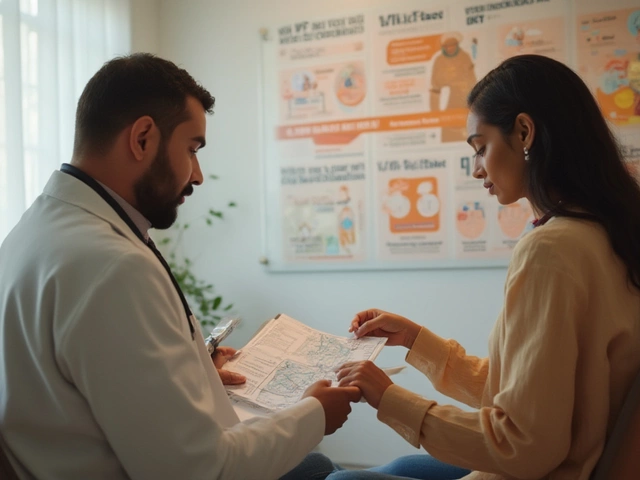The words "stage 4" feel like a punch in the gut. Most people think it's a death sentence, but hang on a second—is that really true? If you've just heard a doctor say "stage 4," you're probably searching for straight answers, not sugarcoating or jargon.
Stage 4 cancer means the cancer has spread to other parts of the body. But here's the twist: it doesn't always mean terminal. Some folks live years—sometimes many—with stage 4 cancer. It depends on the type of cancer, where it spread, and how it responds to treatment.
Doctors use "stage 4" for technical reasons, not to predict exactly how long you'll live. Plus, medicine isn’t standing still—treatments get better every year, and new options keep popping up that can shrink tumors, control symptoms, and sometimes send cancer into remission.
All that medical talk can feel confusing and heavy. If someone you care about just got told they've got stage 4 cancer, focus on getting real facts—not myths. There's a big difference between something being incurable (can't ever get rid of it totally) and being terminal (no more treatment can help). That distinction matters a lot.
- What Does Stage 4 Really Mean?
- Is Stage 4 Always Terminal?
- How Doctors Decide: Terminal vs. Treatable
- Treatment Options for Stage 4 Cancer
- Living with Stage 4: Real-Life Insights
- Tips for Patients and Loved Ones
What Does Stage 4 Really Mean?
When you hear "stage 4 cancer," you’re really dealing with a medical system that needs a way to figure out how far cancer has spread. Doctors use “staging” to keep everyone on the same page when they talk about cancer. Stage 4 is the highest stage, meaning the cancer has moved beyond where it started and has reached other organs or parts of the body. This is also called metastatic cancer.
Let’s break it down with a quick look at the stages:
- Stage 0: Cancer is only in the layer of cells where it began.
- Stage 1: Smaller tumors, no spread to lymph nodes.
- Stage 2: Usually larger tumors or spread to nearby lymph nodes.
- Stage 3: Even more spread to lymph nodes or nearby tissues.
- Stage 4 cancer: Cancer has spread (metastasized) far away from the original spot.
The key with stage 4 is the word "spread." For example, breast cancer can show up in the bones, liver, or brain. Lung cancer might pop up in the adrenal glands. What kind of cancer you have still depends on where it started, so if it started in the colon but spread to the liver, it’s still colon cancer, not liver cancer.
The numbers tell a story too. According to data collected by the National Cancer Institute:
| Cancer Type | 5-Year Survival (Stage 4) |
|---|---|
| Breast | 31% |
| Lung | 8% |
| Colon | 15% |
| Prostate | 32% |
Those stats might look tough, but remember that they're averages. Some people respond super well to treatment, while others don't.
Doctors figure out if it's stage 4 by using scans (like MRI, CT, or PET scans), blood tests, and sometimes even surgery. The point is to find out exactly where the cancer has traveled, so they can plan out the best treatment.
Is Stage 4 Always Terminal?
This is the million-dollar question. The short answer? No, stage 4 cancer isn't always terminal. That word 'terminal' gets tossed around a lot, but it actually means there's no treatment left that can control the cancer or ease symptoms. Just being stage 4 doesn't automatically mean you're at that point.
Here’s the truth: Stage 4 means the cancer has spread—usually to distant organs or lymph nodes. While that sounds grim, a lot depends on what kind of cancer you have. For example, people with some types of stage 4 breast or prostate cancer can live for years, even decades, with the right mix of treatments. On the flip side, cancers like pancreatic or lung cancer tend to be tougher to control after spreading, but even here, outcomes can surprise you.
Modern treatment is a game changer. Advances like immunotherapy, targeted drugs, and even new combinations of old standbys (like chemo and radiation) have helped some folks live much longer than doctors used to expect. There’s even a medical term—"chronic cancer"—for folks whose cancer can't be cured but can be managed in the long run, like a chronic illness.
Here’s a look at the five-year survival data for common stage 4 cancers:
| Cancer Type | Average 5-Year Survival Rate (Stage 4) |
|---|---|
| Breast | 30% |
| Prostate | 32% |
| Colon | 14% |
| Lung | 8% |
| Pancreatic | 3% |
Notice those survival rates aren't zero—far from it. These numbers don’t tell your or your loved one’s whole story, but they show that the outcome isn’t always what people fear. Some people even go into remission for long stretches.
One real-life tip: Always ask your doctor, “Is my cancer terminal, or is it considered incurable but treatable?” It’s an important difference. Doctors can tailor your care to your situation and goals—sometimes aiming for years of good life, not just weeks or months.
How Doctors Decide: Terminal vs. Treatable
This part always trips people up. You hear stage 4 cancer, you assume it’s terminal, but that’s not how doctors make the call. The main idea? “Terminal” means you’ve got months at best and treatment can’t slow things down anymore. “Treatable” means there are still options to control, shrink, or even stall the cancer for a while—even if a cure isn’t possible.
Doctors look at a bunch of stuff before using the word “terminal.” Here’s what usually matters the most:
- How fast the cancer is growing and spreading
- If it’s responding to treatment (like chemo, immunotherapy or targeted drugs)
- Your overall health—can you handle more treatment?
- Which organs the cancer’s reached and how well they’re working
- Your symptoms and if they’re getting worse
Sometimes, people with stage 4 cancer can live for years, especially if the cancer responds to newer drugs. A classic example: some people with stage 4 breast, prostate, or colon cancer get good mileage out of the right mix of meds. On the flip side, some cancers move so fast even the best treatments can’t slow them down. That’s when it shifts from “treatable” to “terminal.”
Check out this breakdown based on studies published in 2023 for rough survival rates:
| Type of Cancer | Median Survival (Months) | Treatments Available |
|---|---|---|
| Breast (stage 4) | 36-60 | Hormone therapy, chemo, targeted therapy |
| Colon (stage 4) | 24-30 | Chemo, immunotherapy, targeted therapy |
| Lung (stage 4) | 7-15 | Chemo, targeted therapy, immunotherapy |
| Pancreatic (stage 4) | 3-6 | Chemo, some targeted options |
Real talk: No doctor has a crystal ball. They can share stats, but everyone’s story is unique. The best move? Ask straight-up questions: “Are we treating to cure, control, or just to help me feel better?” That will tell you if things are still treatable or really are terminal.

Treatment Options for Stage 4 Cancer
Hearing “stage 4” can make anyone feel stunned, but the treatment toolbox is bigger than you might think. No, it’s not just about giving up—people with stage 4 cancer can get all kinds of therapies. Sometimes the aim is to slow things down, control symptoms, and squeeze out as much good time as possible. Sometimes, therapy actually shrinks the cancer.
"Even for advanced-stage cancers, treatment is changing fast—and people are living longer than ever before," says Dr. Anurag Mehta from India’s Rajiv Gandhi Cancer Institute.
Let’s break down what the options look like:
- Chemotherapy: This is the go-to for many cancers. The goal can be to shrink tumors, stop them from growing, or just help you feel better.
- Targeted Therapy: Got cancer with a certain gene or protein? These medicines can home in on it. There’s less collateral damage to the rest of the body, so side effects can sometimes be easier to handle.
- Immunotherapy: This treatment uses your own immune system to fight cancer—pretty wild, right? Some stage 4 patients, especially with lung cancers or melanoma, have seen amazing results.
- Radiation: It can shrink painful tumors or help control symptoms. Even if it’s spread, some spots still get zapped for relief.
- Surgery: Less common at stage 4, but sometimes doctors remove a main tumor or certain spots to help with symptoms or boost the effects of drugs.
- Palliative Care: This isn’t “giving up.” It’s about managing pain, nutrition, energy, and mental health—basically, getting as much quality out of the day as possible.
Newer combos are getting popular—immunotherapy plus chemo, or mixes with targeted drugs. Each cancer type reacts differently, so what works for one person might not do much for another.
| Treatment | Purpose | Common Use |
|---|---|---|
| Chemotherapy | Shrink/slow cancer, symptoms | Nearly all stage 4 types |
| Targeted Therapy | Attack specific mutations | Lung, colon, breast, some blood cancers |
| Immunotherapy | Boost immune system | Melanoma, lung, bladder, more |
| Radiation | Relieve pain; shrink spots | Bone, brain, tumors causing blockage |
| Palliative Care | Quality of life, symptom control | Any advanced cancer |
Lots of patients also ask about clinical trials. These can be a game-changer—sometimes folks get access to brand-new drugs not found in regular hospitals. Always good to ask your cancer specialist if there’s a trial you might qualify for.
I’ve seen people in my circle, even friends of Neha, go way beyond their doctor’s original timeline. That’s real hope you can hang onto. Keep asking questions, and remember—new treatments show up every year.
Living with Stage 4: Real-Life Insights
Living with stage 4 cancer doesn’t look the same for everyone. Some people can’t wait to tackle their bucket list; others just want to get through a day without pain or fatigue. Even though stage 4 means the cancer has spread, there's no single timeline or rulebook. In fact, recent numbers from the American Cancer Society show that nearly 22% of people diagnosed with stage 4 breast cancer live five years or longer. You’ll find similar stats for certain types of prostate and colon cancers too.
Here’s what daily life can actually look like for someone with stage 4 cancer:
- Treatment schedules: You might have regular infusions, oral meds, or targeted therapies. Some people need treatments every few weeks, others less often.
- Work and hobbies: Many people keep working, volunteering, or enjoying hobbies. Adjusting work hours or taking breaks is pretty common.
- Symptoms to manage: Tiredness tops the list, but pain, appetite changes, and brain fog can pop up. Docs help manage these with medications or lifestyle tweaks.
- Mental health: It’s totally normal to have ups and downs. Support groups, therapy, and talking openly with family can make a huge difference. Apps like Calm or Headspace are also gaining ground for everyday stress relief.
Some folks with stage 4 cancer go months or even years without the disease getting worse, thanks to new treatments. Here’s a quick snapshot of recent survival data for common cancers at stage 4:
| Type of Cancer | Median Survival (months) | 5-Year Survival Rate (%) |
|---|---|---|
| Breast | 36 | 22 |
| Prostate | 67 | 31 |
| Colon | 30 | 14 |
| Lung (NSCLC) | 10 | 7 |
Of course, stats don’t tell your whole story. One friend of mine, Rajesh, has been living with stage 4 colon cancer for four years. He goes for chemo every three weeks and still takes his dog on jogs most mornings. He says finding the right doctor, asking questions, and connecting with people in the same boat has helped him take back some control.
Keeping a sense of normalcy matters. Even small wins—like making a favorite meal or spending time with friends—can boost your mood big time. Treatments might be tough, but life does keep moving on, and so do those living with stage 4 cancer.
Tips for Patients and Loved Ones
Hearing the words "stage 4 cancer" can turn your world upside down. It’s tough to know what to do next, and honestly, most people feel lost at first. Here are practical tips for patients and those close to them, so you don’t have to stumble around in the dark.
- Ask direct questions. Don't be shy in the doctor’s office. Questions like "Is my cancer treatable?", "What’s the main goal of my treatment?", or "How do you define terminal?" clear up a lot of confusion over what stage 4 cancer actually means for you specifically.
- Write things down at appointments. Bring a notebook or use your phone. When you’re hit with heavy news, it’s easy to miss key details. Notes help you remember options and next steps.
- Get a second opinion. This isn’t doctor shopping. Cancer care can be complicated—even expert doctors might suggest different treatments or perspectives on your case.
- Understand your treatment options. From chemotherapy and radiation, to targeted therapies and immunotherapy, advances keep changing the landscape. Ask which treatments fit your cancer type and how aggressive they are.
- Consider joining a clinical trial. Trials aren’t just a last resort—they can offer access to newer treatments you won’t get elsewhere. You can search for open studies online or ask your oncology team about options.
- Don’t ignore mental health. It’s normal to feel overwhelmed, anxious, or angry. Support groups, a good therapist, or even honest talks with friends can relieve stress and make facing decisions easier.
- Talk openly about the big stuff. Conversations with family about your wishes—whether you want to keep fighting no matter what, or how you feel about hospice care later on—save a lot of stress and guessing down the road.
- Let people help. If someone offers to cook, drive you to appointments, or just sit with you when you’re down, say yes when you can. Even little bits of support can give you much-needed breathing space.
Pushing through stage 4 cancer isn’t just about medical stuff. Staying connected, asking the right questions, and being honest with yourself and your loved ones really can make a huge difference.





